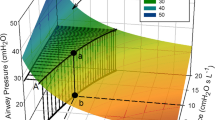Abstract
We have previously shown that the pressure-flow relationship of the upper airway during nonrapid eye movement sleep can be characterized by a polynomial equation: F(P) = AP3 + BP2 + CP + D. On the basis of fluid mechanic principles, we hypothesized that we could objectively calculate upper airway resistance (RUA) using the polynomial equation. We manually measured RUA (mRUA) from the first linear portion of a pressure-flow loop in 544 breaths from 20 subjects and compared the mRUA to the RUA calculated from the polynomial equation (cRUA). Bland-Altman analysis showed that the mean difference between mRUA and cRUA was 0.0 cm H2O/L/s (95% CI, 0.1 to 0.1 cm H2O/L/s) with an upper limit of agreement of 2.0 cm H2O/L/s (95% CI, 1.9 to 2.1 cm H2O/L/s) and a lower limit of agreement −2.0 cm H2O/L/s (95% CI, −2.1 to −1.9 cm H2O/L/s). Additional Bland-Altman analyses showed that the agreement between the two measures was excellent for both inspiratory flow-limited and non-flow-limited breaths. We conclude that RUA can be measured in a simple, objective, and reproducible fashion from a polynomial function that characterizes the upper airway pressure-flow relationship.
Similar content being viewed by others
References
Badr MS, Kawak A, SkatrudJB, Morrell MJ, Zahn BR, Babcock MA. Effect of induced hypocapnic hypopnea on upper airway patency in humans during NREM sleep. Respir Physiol 1997;110:33–45
Series F, Cormier Y, Couture J, Desmeules M. Changes in upper airway resistance with lung inflation and positive airway pressure. J Appl Physiol 1990;68:1075–1079
Anch AM, Remmers JE, Bunce III H. Supraglottic airway resistance in normal subjects and patients with occlusive sleep apnea. J Appl Physiol 1982;53:1158–1163
Rowley JA, Zahn BK, Babcock MA, Badr MS. The effect of rapid eye movement (REM) sleep on upper airway mechanics in normal human subjects. J Physiol 1998;510:963–976
Rowley JA, Sanders CS, Zahn BK, Badr MS. The effect of rapid-eye movement (REM) sleep on retroglossal cross-sectional area and compliance in normal subjects. J Appl Physiol 2001;91:239–248
Kay A, Trinder J, Bowes G, Kim Y. Changes in airway resistance during sleep onset. J Appl Physiol 1994;76:1600–1607
Kay A, Trinder J, Kim Y. Progressive changes in airway resistance during sleep. J Appl Physiol 1996;81:282–292
Pillar G, Malhotra A, Fogel R, Beauregard J, Schnall R, WhiteDP. Airway mechanics and ventilation in response to resistive loading during sleep: influence of gender. Am J Respir Crit Care Med 2000;162:1627–1632
Wiegand L, ZwillichCW, White DP. Collapsibility of the human upper airway during normal sleep. J Appl Physiol 1989;66:1800–1808
Series F, Cormier Y, Desmeules M. Influence of passive changes of lung volume on upper airways. J Appl Physiol 1990;68:2159–2164
Trinder J, Kay A, Kleiman J, Dunai J. Gender differences in airway resistance during sleep. J Appl Physiol 1997;83:1986–1997
Thurnheer R, WraithPK, Douglas NJ. Influence of age and gender on upper airway resistance in NREM and REM sleep. J Appl Physiol 2001;90:981–988
Rowley JA, Zhou ZS, Vergine I, ShkoukaniBS, Badr MS. The influence of gender on upper airway mechanics: upper airway resistance and Pcrit. J Appl Physiol 2001;91:2248–2254
Tamisier R, Pepin JL, WuyamB, Smith R, Argod J, Levy P. Characterization of pharyngeal resistance during sleep in a spectrum of sleep-disordered breathing. J Appl Physiol 2000;89:120–130
Mansour KF, Rowley JA, Meshenish AA, Shkoukani MA, Badr MS. A mathematical model to detect inspiratory flow limitation during sleep. J Appl Physiol 2002;93:1084–1092
Hudgel DW, Hendricks C, HamiltonHB. Characteristics of the upper airway pressure-flow relationship during sleep. J Appl Physiol 1988;64:1930–1935
Rohrer F. The resistance in the human airway and the influence of branching of bronchial systems on frequency of breathing at different lung volumes. Pflugers Arch 1915;162:255–299
Olson LG, Fouke JM, Hoekje PL, Strohl KP. A biomechanical view of upper airway function. In: Mathew OP, Sant’Ambrogio G, eds. Respiratory Function of the Upper Airway. New York: Marcel Dekker; 1988:359–389
White FM. Viscous Fluid Flow. New York: McGraw-Hill;1991
Rossi A. Resistance measurement in ventilator-dependent patients. In: Milic-Emili J, Lucangelo U, Pesenti A, Zin WA, eds. Basics of Respiratory Mechanics and Artificial Ventilation. Milan, Italy: Springer; 1999:81–85
Bland JM, Altman DG. Statistical methods for assessing agreemtn between two methods of clinical measurement. Lancet 1986;1:307–310
Jaeger MJ, Matthys H. The pattern of flow in the upper human airways. Respir Physiol 1968;6:113–127
Author information
Authors and Affiliations
Corresponding author
Rights and permissions
About this article
Cite this article
Mansour, K., Badr, M.S., Shkoukani, M.A. et al. Mathematical Determination of Inspiratory Upper Airway Resistance Using a Polynomial Equation. Sleep Breath 7, 151–158 (2003). https://doi.org/10.1007/s11325-003-0151-3
Issue Date:
DOI: https://doi.org/10.1007/s11325-003-0151-3




